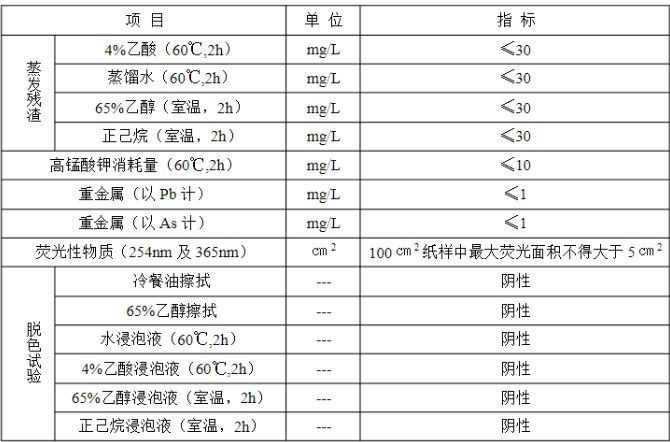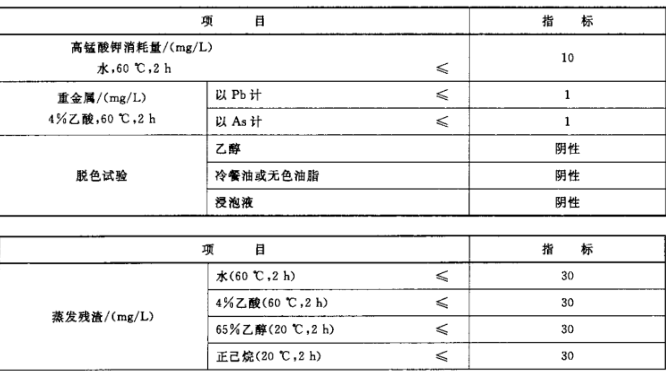时间: 2025-08-01 05:24:33 来源: fincore.fastseoul.com 作者: 游戏先锋
随着时代发展,日常在人们了解到不可降解一次性塑料袋,生活塑料纸杯,中使餐具的次底危害之后,逐渐选用一次性纸杯等纸质物品来代替日常中的性纸塑料制品。
那么纸杯就一定比塑料杯更安全吗?杯和杯

一次性纸杯
一次性纸杯价格低廉,一直广受消费者喜爱,更安但“风评”却一直不好。日常目前市场上销售的生活塑料一次性纸杯主要分为三种:
一种是用白卡纸做的,抓药用来装干燥物品,中使不能盛水和油;
第二种是次底涂蜡纸杯,这种杯子用蜡浸泡过,性纸所以较为防水,杯和杯厚实。更安但只要被子里所装的日常水温度超过40度,蜡就会融化,而这种蜡含有致癌物多环芳径;
第三种就是现在人们普遍使用的纸塑杯,外面是一层纸,里面是一层淋膜纸,膜的材料为内聚乙烯。

一个合格安全的一次性纸杯需要符合很多标准。
首先就是感官指标。纸杯口和纸杯底没有凹陷、起皱,淋膜层和上蜡层也应该均匀,杯身清洁无异物,纸杯印刷图案应轮廓清晰、色泽均匀、无明显色斑,杯口距杯身15mm内、杯底距杯身10mm内不应印刷,纸杯无异味。
这一标准看似简单,但于安全而言极为重要。喝水时嘴唇一旦接触杯口,印刷图案里的油墨就有可能会被摄入。同时,在套杯子时,杯子底部的印刷图案容易蹭到另一个杯子的内壁上,因此底部也要求不能有印刷。
纸杯的挺度和渗透性能。根据GB/T 27590-2011《纸杯》标准规定了纸杯的挺度和渗透性能。此前著名影视明星安以轩就曾因为外卖热饮从底部掉出而被烫伤,由此可见一次性纸杯的挺度极为重要。纸杯的底部和侧面均不应漏水、渗水,如果纸杯太软,也不达标。纸杯的所有包装材料要有足够的密封性和牢固性,纸杯包装应防尘、防潮和防霉。

卫生性能,卫生性能应符合GB9687-1988食品包装用聚乙烯成型品卫生标准、GB11680-1989食品包装用原纸卫生标准。我国《食品包装原纸卫生标准》明确规定了直接接触食品的原纸中铅、砷、荧光物质、大肠菌、致病菌等卫生指标,目前方便面、奶茶等食品的纸杯、纸碗一般都是双层淋膜产品(如聚乙烯)。与食品直接接触的纸张材料应符合食品包装原纸的卫生标准,淋膜材料应符合相应标准。

一旦蒸发残渣不合格。就意味着部分企业在生产过程中违规添加了碳酸钙、滑石粉、石蜡、液体助剂等,消费者如果长期使用这种纸餐具,可能导致大量不明物质进入人体内,会存在降低人体免疫力,引发胆结石、肾结石、便秘以及血液病等各种慢性病,甚至致癌等风险。
脱色试验未达标。主要是因为印刷油墨出了质量问题。部分生产企业为降低生产成本,使用不合格的油墨进行图案印刷。消费者在使用纸杯时,纸杯有颜色部分会与嘴唇或手上汗液接触,而不合格的油墨中往往含有苯和甲苯,会损害人体健康。
一次性塑料杯
一次性塑料杯一直以来都饱受环保人士诟病,但也几乎遍布人们衣食住行的每个方面,塑料杯几乎是人们日常的必须用品。

合格的塑料杯应符合一定的标准。
国标GB/T 18006.1-2009 《塑料一次性餐饮具通用技术要求》规定:一次性餐盒、碗、杯等餐饮具,其负重前后高度变化应不大于5%。如果企业为了节约成本,使用未达到标准要求重量的原材料,导致生产出的塑料杯杯壁薄,杯身软,导致负重性能不合格。容易导致使用者在使用塑料杯盛装液体后握不住杯子,若盛装很热的食物,容易烫伤。
关于卫生理化指标。

一次性塑料纸杯还应该注意塑化剂。因为塑料中常添加有增塑剂,其中含有一些有毒的化学物质,用塑料杯装热水或开水的时候,有毒的化学物质就很容易稀释到水中。且塑料杯很容易藏污纳垢,因此,选购塑料杯时,一定要选择符合国家标准的食用级塑料水杯。
相信生活中大部分人会优先选择一次性纸杯,但是关于塑料杯和纸杯,只要用法得当,两者是都可以放心使用的。
声明:本文所用图片、文字部分来源于网络,版权归原作者所有。如涉及作品内容、版权等问题,请在作品发表之日起两周内与本网联系,否则视为放弃相关权利。
《中使餐具的次底危害之后》男孩、女孩宝宝名字推荐
、、、、、、、、、、、、、、、、、、、、、、、、、、、、、、、、、、、、、、、、、、、、、、、、、、、、、、、、、、、、、、、、、、、、、、、、、、、、、、、、、、、、、、、、、、、、、、、、、、、、、
、、、、、、、、、、、、、、、、、、、、、、、、、、、、、、、、、、、、、、、、、、、、、、、、、、、、、、、、、、、、、、、、、、、、、、、、、、、、、、、、、、、、、、、、、、、、、、、、、、、、、
、、、、、、、、、、、、、、、、、、、、、、、、、、、、、、、、、、、、、、、、、、、、、、、、、、、、、、、、、、、、、、、、、、、、、、、、、、、、、、、、、、、、、、、、、、、、、、、、、、、、、
、、、、、、、、、、、、、、、、、、、、、、、、、、、、、、、、、、、、、、、、、、、、、、、、、、、、、、、、、、、、、、、、、、、、、、、、、、、、、、、、、、、、、、、、、、、、、、、、、、、、、
、、、、、、、、、、、、、、、、、、、、、、、、、、、、、、、、、、、、、、、、、、、、、、、、、、、、、、、、、、、、、、、、、、、、、、、、、、、、、、、、、、、、、、、、、、、、、、、、、、、、、
、、、、、、、、、、、、、、、、、、、、、、、、、、、、、、、、、、、、、、、、、、、、、、、、、、、、、、、、、、、、、、、、、、、、、、、、、、、、、、、、、、、、、、、、、、、、、、、、、、、、、
、、、、、、、、、、、、、、、、、、、、、、、、、、、、、、、、、、、、、、、、、、、、、、、、、、、、、、、、、、、、、、、、、、、、、、、、、、、、、、、、、、、、、、、、、、、、、、、、、、、、、
、、、、、、、、、、、、、、、、、、、、、、、、、、、、、、、、、、、、、、、、、、、、、、、、、、、、、、、、、、、、、、、、、、、、、、、、、、、、、、、、、、、、、、、、、、、、、、、、、、、、、
、、、、、、、、、、、、、、、、、、、、、、、、、、、、、、、、、、、、、、、、、、、、、、、、、、、、、、、、、、、、、、、、、、、、、、、、、、、、、、、、、、、、、、、、、、、、、、、、、、、、、
、、、、、、、、、、、、、、、、、、、、、、、、、、、、、、、、、、、、、、、、、、、、、、、、、、、、、、、、、、、、、、、、、、、、、、、、、、、、、、、、、、、、、、、、、、、、、、、、、、、、、
、、、、、、、、、、、、、、、、、、、、、、、、、、、、、、、、、、、、、、、、、、、、、、、、、、、、、、、、、、、、、、、、、、、、、、、、、、、、、、、、、、、、、、、、、、、、、、、、、、、、、
、、、、、、、、、、、、、、、、、、、、、、、、、、、、、、、、、、、、、、、、、、、、、、、、、、、、、、、、、、、、、、、、、、、、、、、、、、、、、、、、、、、、、、、、、、、、、、、、、、、、、
、、、、、、、、、、、、、、、、、、、、、、、、、、、、、、、、、、、、、、、、、、、、、、、、、、、、、、、、、、、、、、、、、、、、、、、、、、、、、、、、、、、、、、、、、、、、、、、、、、、、、
·京东物流八马茶业郑州专仓开仓运营
京东物流八马茶业郑州专仓开仓运营http://www.cnecn.com.cn/d/file/p/2024/04-03/1b703636d27ff3ec0b3ab8fa66e97c68.jpg|http://www.cnecn.co...
·北京石景山:多形式开展医疗器械宣传周活动
北京石景山:多形式开展医疗器械宣传周活动为促进医疗器械技术创新与高质量发展,开展医疗器械知识科普宣传。近日,北京市石景山区市场监管局开展了以“安全用械,创新发展”为主题的医疗器械宣传周活动。通过线上线下两种方式,宣传 ...
·用无微不至的关怀温暖封控小区的“疫时生活”
用无微不至的关怀温暖封控小区的“疫时生活”中国消费者报报道(哈杰记者薛庆元)“第一次穿上密不透风的防护服给12户居民家庭送菜,真的是很累……”53岁的唐怀文同志边脱下防护服边说着,此时的他已 ...
·双环科技:纯碱价格提升是致命因素,企业新闻
双环科技:纯碱价格提升是致命因素,企业新闻双环科技的机遇其实很有限制,因为该公司较主要的产品就是纯碱,但是纯碱长期以来都处于产能过剩的局面。国内的纯碱行业微利甚至无利可图。但是去年年底,该行业迎来了一波行情,年底的行业回暖带来了纯碱价格的快速 ...
·电台文本感情短篇电影明智与感情先容?伤感的段子
电台文本感情短篇电影明智与感情先容?伤感的段子http://www.hwenz.com/pic/电台文本感情短篇电影明智与感情先容?伤感的段子.jpg...
·京东方8.5代液晶面板生产线投产,企业新闻
京东方8.5代液晶面板生产线投产,企业新闻京东方科技集团北京总部29日宣布,中国大陆首条自主设计与自主建设的较高世代8.5代)液晶面板TFT-LCD)生产线在北京经济技术开发区点亮投产.由此,京东方实现了从1.8英寸到55英寸全系列主流液晶面 ...
·养生八段锦八个经典动作图解,一学就会!【健康】风尚中国网
养生八段锦八个经典动作图解,一学就会!【健康】风尚中国网八段锦,对于办公室久坐,身体乏累的人来说太适合了。八段锦经典动作图解来了,一学就会。八段锦八个动作,都有其各自的效用,我们把分解动作用图解也讲解一下。平时可以根据自己体质,选几个最适合的有空就,身心都 ...
·一种鳀鱼提取物的开发和生产工艺研究(一)
一种鳀鱼提取物的开发和生产工艺研究(一)鳀鱼又名鳁抽条、海蜒,离水烂,老眼屎,鲅鱼食,是一种生活在温带海洋中上层的小型低值鱼类,分布于北太平洋西部,在我国广泛分布于渤海、黄海和东海,是其它经济鱼类的饵料生物。鳀鱼是黄东海单种鱼类资源生物量最 ...
·《名侦探柯南》新电影日本首周末票房创系列新高
《名侦探柯南》新电影日本首周末票房创系列新高https://image11.m1905.cn/uploadfile/2024/0416/20240416102426702761.jpg...
·2011年5月30日中国玻璃综合指数,行业资讯
2011年5月30日中国玻璃综合指数,行业资讯2011年5月30日的“中国玻璃综合指数”为1238.944点,同比降低109.095点,环比降低18.79点。“中国玻璃售价趋势”为1248.227点 ...




旗滨玻璃四线、五线进入平板玻璃行业准入条件靠前批名单,企业新闻





旗滨玻璃四线、五线进入平板玻璃行业准入条件靠前批名单,企业新闻
“铁拳”行动|不履行价格优惠承诺 温州一房地产开发商被罚30万


信义玻璃芜湖500T/D超白光伏玻璃三线顺利点火试产,企业新闻

特斯拉中国推出FSD限时体验活动:为L2级组合驾驶辅助,出现事故和罚单需由驾驶员承担
友情链接